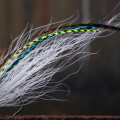Ask MidCurrent: Is an Improved Clinch Knot Always Better Than a Regular Clinch Knot?
Question: I have always used an improved clinch knot to tie on my fly, but I was recently told that sometimes the regular clinch is better. Is this true, and when should I not improve the knot?
—Bob B., Portland, OR (via the Ask MidCurrent form)
Answer: Every time you mention the clinch knot, people come out of the woodwork to tell you why the knot is weak and which of the myriad other leader-to-fly knots is better. For any knot out there, you’ll find anglers who swear by it. That said, the clinch knot—standard or improved—is still far and away the most popular connection out there.
The standard clinch knot is a simple, time-tested knot where the line is wrapped around itself and the tag end is passed through the loop at the hook eye. Holding the tag end, you lubricate the knot and cinch it tight. If it’s tied correctly, this knot works great in most situations. However, it does have a tendency to slip when used with larger tippet sizes or large-wire hooks. There are few things worse than losing a a fish only to find the telltale curlicue at the end of the tippet where the fly used to be.

The improved clinch adds one extra step: after passing the tag end through the loop at hook eye, you go through the loop formed by tag end and the wraps. Then you lubricate and cinch it. This “improvement” locks the tag end in place more securely, making the knot less likely to slip. In essence, the improved clinch is a slightly more complex version designed to address the standard clinch knot’s potential weaknesses.
Relative Strength
Accurate knot-testing data is notoriously hard to come by because there are so many variables in play: are the knots equally well-tied? Is the tippet material dry or wet during testing? Which brand of tippet material are you using? Does the test include both nylon and fluorocarbon? Is the sample size large enough to be statistically sound? And on and on. In general, improved clinch knots test a bit stronger than standard clinch knots. For example, one Field & Stream test found that an improved clinch retained about 86% of the line’s strength, whereas the standard clinch was in the ballpark of 75-80%. So your trusty standard clinch offers you a stronger connection on average.
The improved clinch’s extra tuck definitely makes it less prone to slipping than a standard clinch. This is especially true if the knots aren’t tied perfectly. A loosely or improperly tied standard clinch will almost certainly fail, while the the improved clinch is a bit more forgiving because of the extra safety provided by the extra step.
Ease of Tying and Trade-offs
The big benefits of the standard clinch are its simplicity, how quickly you can tie it, and its small profile. Most folks can tie it even in low light or with cold hands. Its simplicity also means you can tie it more consistently well under fishing conditions. An improved clinch, while only adding one step, does demand a bit more attention to tie correctly. One downside noted by some anglers is that the improved clinch can twist; if the coils overlap incorrectly or the knot isn’t cinched neatly, you lose the strength advantage.
Whichever version you use, practice is key. Tie whichever knot you can execute confidently and cleanly. Still, with a bit of practice, most anglers can tie the improved clinch almost as quickly as the regular clinch. The slight extra effort often pays off in a stronger, more secure knot.
Where the Standard Clinch Shines
Testing aside, many expert anglers firmly believe that the standard clinch is both stronger and more effective when you’re using very light tippet material and small flies. The simplicity of the standard clinch means it’s easier to tie perfectly—working with 6X or 7X on a size 22 hook is a fussy enough process without the final “improvement”—and it offers fewer places for the knot to cut into the light tippet material. The standard clinch also looks much less bulky in relation to the tiny fly.
Conclusions
If you’re only going to use one knot, the improved clinch is your best choice because it’s stronger in more situations. But if you fish with very small flies—especially dry flies—the standard clinch can be a better option.
As with any discussion of knots there is one universal truth: the best knot is a well-tied knot. So whichever knot you plan to use, practice tying it, under all conditions—and don’t forget to lubricate it with saliva before you cinch it.
Got a question for our experts? Click here!











